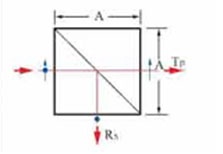我们的分光板可用于高功率激光系统。在使用分光板时,两个光束在不同的光路中传输,光路取决于入射角和板的厚度。
偏振分光棱镜由两个直角棱镜胶合而成,其中一个棱镜的斜面镀有偏振介质膜。当与正常入射、非偏振光一起使用时,入射光被分成两束偏振光,P偏振光可直接穿过,S偏振光以90°角反射出来。
产品产地:
中国航运港口:
中国福州交付周期:
四周付款:
银行电汇, 西联付款
1. 什么是偏振分光棱镜?
偏光分光棱镜由两个直角棱镜粘合在一起构成。一棱镜的斜面镀有一层特殊的多层介质膜。当圆偏振光或自然光垂直进入立方体时,它被分成两条线偏振光。透过的光束为P偏振光,反射光束为S偏振光。当线偏振光进入时,它同样分成两束。但是,两个输出光束的能量比取决于入射光束的偏振。偏振分光棱镜可用于许多激光波长和宽带范围。
2. 偏振分光棱镜如何工作?
偏光分光棱镜的设计目的是在特定的反射率/透射率比下(r/t),以不确定的偏振趋势分离未极化的光。偏振光分光棱镜设计用于将光分为反射的S偏振光和透射的P偏振光。
3. 偏振分光棱镜有哪些用途?
分光棱镜也是一种滤光片,用于激光束的分离和组合。但偏振分光棱镜是用来分散或组合两个垂直偏振激光束。偏振分光棱镜的性能取决于其具体镀膜规格。它们是激光或照明系统中的常见部件。也适用于荧光应用、光学干涉测量、生命科学或半导体仪器。光可以按总强度、波长或偏振状态的百分比进行分散。选择合适的分光棱镜,需考虑类型、镀膜、透过率范围和损伤阈值。
产品规格
材质:BK7 A级光学玻璃
尺寸公差:+/-0.2mm 
平整度:λ/4@633nm
光束公差:最小3弧分
表面质量:60-40 S/D
消光比:100:1
主透过率:tp>95%,ts<1%
主反射比:Rs>99%,Rp<5%
镀膜:斜面偏振分束器镀膜
所有入射和输出面AR镀膜
|
Standard Wavelength(nm) |
488,514.5,532,632.8,635,670, 780,850,980, 1064,1300,1550 |
|||||
| Size (mm) | 3.2x3.2x3.2 | 5x5x5 | 10x10x10 | 12.7x12.7x12.7 | 15x15x15 | 20x20x20 |
| Part NO. | UPBS032 | UPBS005 | UPBS010 | UPBS127 | UPBS015 | UPBS020 |
下一页 :
非偏振分光棱镜(NPBS)